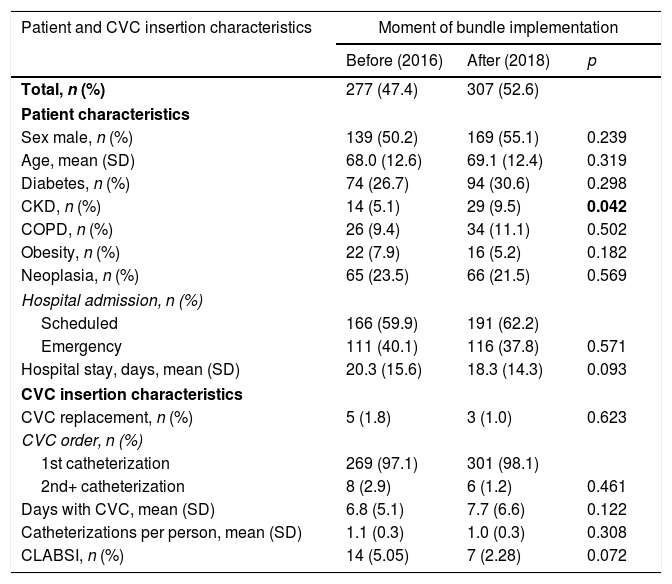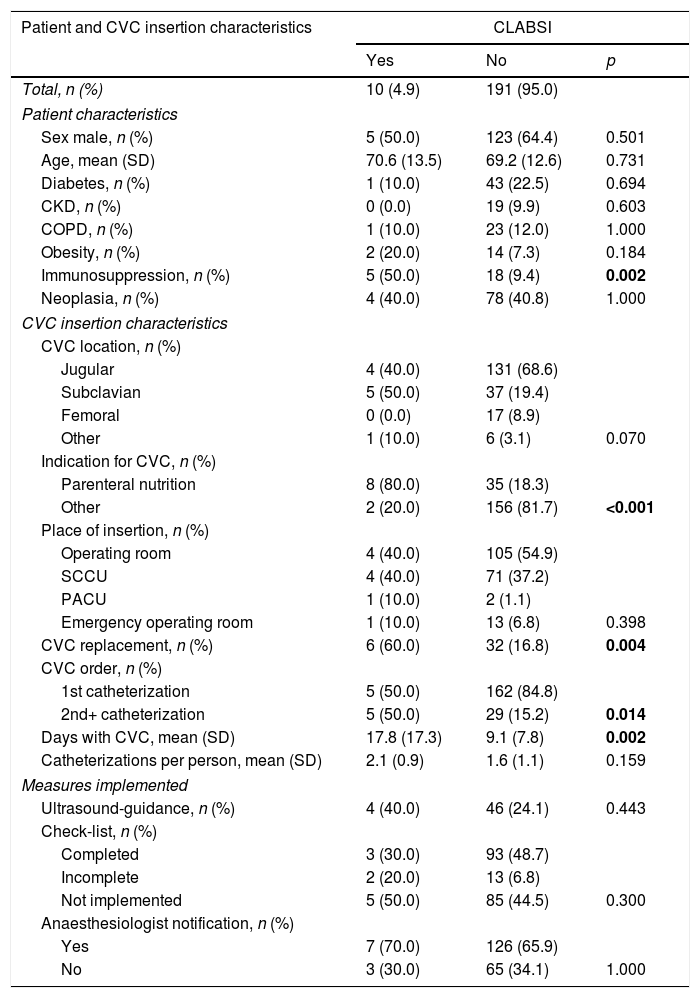Catheter-associated infections are the main cause of nosocomial bacteremia. The main objective of this study was to demonstrate a possible decrease in CLABSI rates in perioperative environment after the implementation of a bundle of measures. Secondary objective was to determine which factors were associated with an increased risk of CLABSI, after the implementation of the bundle.
MethodsInsertion bundle consisted of: subclavian vein as access of choice, disinfection with alcoholic 2% chlorhexidine, central-line full body drapes, sterile ultrasound probe-cable covers and insertion check-list. Cumulative Incidence (CI) and Incidence Density Rate (IR) of CLABSIs were compared before and after the intervention. Associations between patient or CVC characteristic and CLABSI were summarized with odds ratios and 95% confidence interval, obtained from multiple logistic regression, adjusting for age, sex, comorbidities and days with CVC.
ResultsBefore implementing the bundle, from January to November 2016, CI of CLABSI was 5.05% and IR was 5.17‰. In the same period of 2018, CI of CLABSI was 2.28% and IR was 2.27‰, which means a reduction of 54.8% in CI (p=.072) and of 56% in IR (p=.068) In multivariable analyses, replacement of CVC was associated with a higher risk of CLABSI (OR 11.01, 95%CI 2.03–59.60, p=.005), as well as 2 or more catheterizations (OR 10.05, 95%CI 1.77–57.16, p=.009), and parenteral nutrition (OR 23.37, 95%CI 4.37–124.91, p<.001).
ConclusionsCLABSI rates decreased after the implementation of the insertion bundle. CVC replacement, 2 or more catheterizations and parenteral nutrition were associated with CLABSI after bundle implementation.
Las infecciones asociadas a catéter son la principal causa de bacteriemia nosocomial. El objetivo principal fue demostrar una posible disminución en las tasas de bacteriemia asociada a catéter venoso central (BACVC) del entorno perioperatorio tras implementar un paquete de medidas. El objetivo secundario fue determinar qué factores se asociaban a mayor riesgo de BACVC tras la implementación del paquete de medidas.
MétodosEl paquete de medidas consistió en: subclavia como acceso de elección, desinfección con clorhexidina alcohólica 2%, paño estéril de cuerpo entero, funda estéril para ecógrafo y check-list de inserción. La incidencia acumulada (IA) y densidad de incidencia (DI) de BACVC se compararon antes y después de la intervención. La asociación entre las características de pacientes o CVC y BACVC se resumieron mediante odds ratio e intervalos de confianza al 95%, obtenidos mediante regresión logística múltiple, ajustado por edad, sexo, comorbilidades y días con CVC.
ResultadosAntes de la implementación del paquete de medidas entre enero-noviembre de 2016 la IA de BACVC fue 5,05% y de DI 5,17‰. En el mismo periodo de 2018 la IA de BACVC fue 2,28% y de DI 2,27‰, suponiendo una reducción del 54% en IA (p=0,072) y del 56% en DI (p=0,068). En el análisis multivariable se asociaron a mayor riesgo de BACVC: reemplazo del CVC (OR: 11,01; IC 95%: 2,03–59,60, p=0,005), 2 o más cateterizaciones (OR: 10,05; IC 95%: 1,77-57,16; p=0,009) y nutrición parenteral (OR: 23,37; IC 95%: 4,37-124,91; p<0,001).
ConclusionesLas tasas de BACVC disminuyeron tras implementar el paquete de medidas de inserción. El reemplazo del CVC, 2 o más cateterizaciones y la nutrición parenteral se asociaron a BACVC tras implementar el paquete de medidas.











